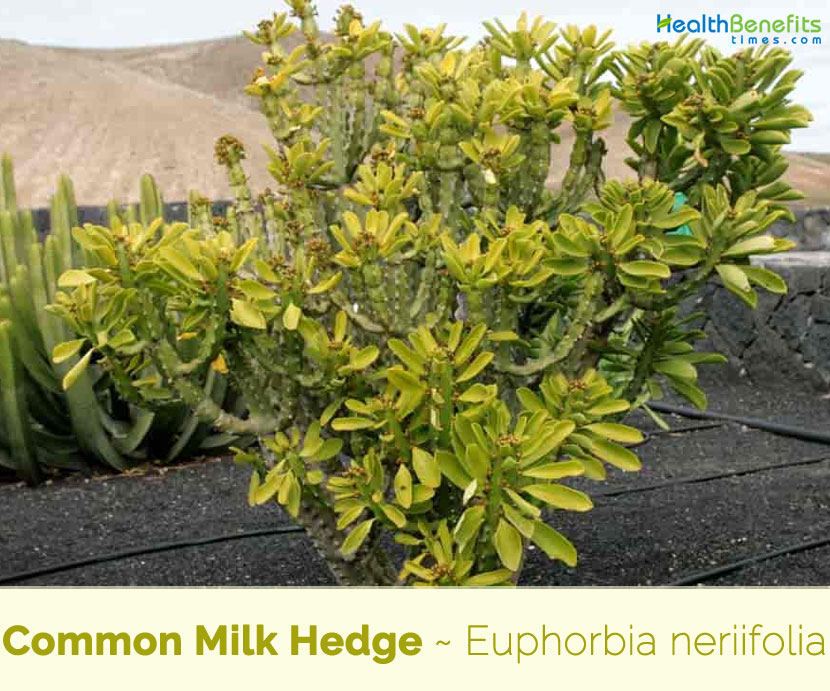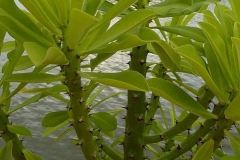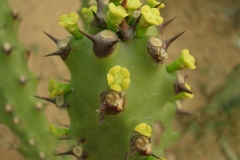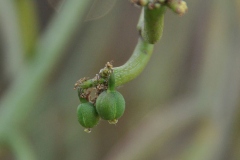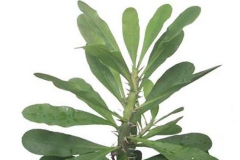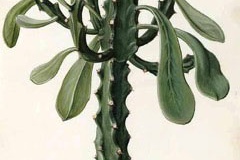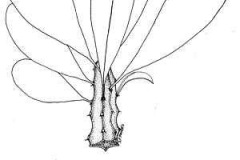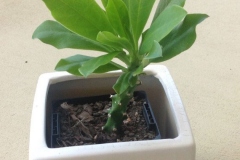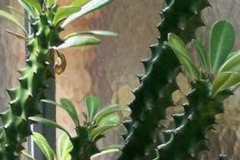| Common milk hedge Quick Facts |
| Name: |
Common milk hedge |
| Scientific Name: |
Euphorbia neriifolia |
| Origin |
South Asia and normally grows around dry, rocky and hilly areas of India, in Myanmar, Thailand and Malaysia |
| Shapes |
Three chambered or 3-lobed capsules that are smooth, stigmas slightly dilated and minutely toothed with 10-12 mm in diameter |
| Taste |
Bitter, acrid |
| Health benefits |
Beneficial for whooping cough, gonorrhea, dropsy, leprosy, asthma, dyspepsia, jaundice, enlargement of the spleen, colic, stone in the bladder, of snake bite and scorpion sting |
Euphorbia neriifolia commonly known as Indian Spurge Tree or Common milk hedge is a prickly, large, erect shrub belonging to Spurge family Euphorbiaceae. The plant is native to dry, rocky and hilly areas of North, Central and South India, mostly in Deccan Peninsula and Orissa. It is indigenous plant of South Asia, but now locally cultivated and naturalizing in Sri Lanka, India, Burma (Myanmar), Bangladesh, Thailand and throughout the Malaysian region except for Borneo; also occasionally cultivated in other topical regions. It is also found in E. Asia – S. China, Vietnam, and New Guinea. Indian Spurge Tree, Oleander Spurge, Dog’s Tongue, Common Milk-hedge, Hedge Euphorbia, Oleander Leafed Euphorbia, Milkbush, Holy Milk Hedge, Hedge Euphorbia, Leafy milk spurge, Milk hedge, Milk spurge and crested oleander cactus are few of the popular common names of the plant.
Plant Description
Common milk hedge is a bitter, xerophytic, and prickly, succulent shrubby, fleshy, large, erect much branched shrub, which sometimes grows into a small tree of 2-8 meters height or more with rounded branches cactus like plant. The tree looks somewhat like a cactus but with large, persistent leaves on younger parts of the plant, and growing up to 8 meters. The plant prefers rocky areas for the growth. They also need well drained soil and grow well in dry place and rocky area.
Stem
Stem is Green and cylindrical and large branches are round and terete with spiral ridge portion. Sharp stipular thorns have hollow space in center that consists of white reticulate mass. Younger branchlets are somewhat verticillate, with two or more whorls without articulations, fleshy, cactus-like, swirled, light-green, glabrous, 8-30 (-40) mm thick, often leafless, and spine shield in 5 distinct rows on more or less distinct angles (not winged) which are visible for a long time. The trunk and older branches are grayish and cylinder. Bunches of succulent thick leaves occurs on the branches. Central meristem is prominent throughout plasto-chronic phases. There is close histogenic relationship between central and peripheral meristem. The leaves arise from the sides of wings towards the end of the branches.
Stippular thorns
The spines are short, about 4-12 mm long arising from the ribs, grayish brown to black in color, sharp, persistent, from low conical truncate distant, spirally arranged tubercles 2-5 mm height and 2-3 cm apart.
Leaves
Plant is leafless for most part of the year, except during monsoon when fresh leaves appear. The fresh young leaves are simple, dark green in color having leathery texture. Apex is rounded, base attenuated, margins entire, hairless, oval shaped leaves, fleshy, alternate, sub sessile, ovate, oblong or spathulate. The surface is glabrous with reticulate venation. The average leaf size is about 8–14 cm long and 4–8cm wide and 1.3 – 0.2 mm thick with pointed and acute tip and are present towards the end of the branches. Peri-clinical divisions in the third and fourth layers of peripheral meristem initiate the leaf. During vegetation period they are deciduous but in the late summer they fall.
Flowers
Both male and female flowers are found in the same bunch. Nearly 3 to 7 flowered cymes or panicles appears laterally in the axils of the upper leaves on short, rigid and forked peduncles. Flattened-globose, 1.5-2 mm x 4-5 mm, reddish, prominent in groups of tree, the central one is sub sessile, the lateral ones with a peduncle of 6-7 mm, cyathial glands 5 oblong, 1-3 mm broad. Corolla is absent but the involucres have two nearly round to ovate, bright red bracts 3-7 mm long. Inflorescence or the arrangement of flowers in a bunch on the plant is cyathium type (one female and several male flowers are found on a same bunch). Basically, male flowers many, bracts linear while female flowers rarely developed. Flowers and fruits occur during the month of December to May.
Fruits
Fertile flowers are followed by three chambered or 3-lobed capsules that are smooth, stigmas slightly dilated and minutely toothed with 10-12 mm in diameter.
Traditional uses and benefits of Common Milk hedge (Indian Spurge Tree)
- Latex obtained from the plant is diuretic, purgative, rubefacient and vermifuge.
- It is used in the treatment of asthma.
- Syrup consisting of equal parts of the latex of this plant with a simple syrup; administered in doses of 10 – 20 drops three times a day; has been found to relieve asthma attacks completely.
- Latex is applied externally on hemorrhoids; is used to relieve sore throat and cracked lips; to treat gonorrhea; and also to remove warts and cutaneous eruptions.
- Bark has been used as a strong purgative.
- Mixed with black pepper, it is used in the treatment of snake bites both internally and externally.
- Leaves are heated, squeezed, and the sap taken, sometimes with salt, to treat asthma, wheezing in babies, colds, and stomach upset.
- Leaves are also used to treat fevers, coughs and colds, and diabetes.
- Applied externally, the sap is used to treat infected nails and to relieve earaches.
- The vaidhyas from ancient times used to use the milky juice exuded from the injured stems as drastic cathartic and to relieve earache.
- They are used as a drastic purgative in the enlargement of liver and spleen, syphilis, dropsy, general anasarca, leprosy,
- Juice mixed with ghee is given in syphilis, in visceral obstructions and in spleen and liver enlargements due to long continued intermittent fevers.
- Externally the juice is applied to remove warts.
- Juice is largely used with clarified or fresh butter as an application to unhealthy ulcers and
- Mixed with Margosa oil it is applied to rheumatic limbs.
- Turmeric powder mixed with the juice of Euphorbia neriifolia is recommended to be applied on piles.
- Thread steeped in the above mentioned mixture is used in ligaturing external Hemorrhoids.
- Root bark boiled in rice-water and arrack is given in dropsy.
- Root mixed with black-pepper is used in scorpion- stings and snake bites, both internally and
- Stem is roasted in ashes and the expressed juice with honey and borax is given in small doses to promote expectoration of phlegm.
- Pulp of the stem mixed with fresh ginger is used to prevent hydrophobia.
- Euphorbia is used for breathing disorders including asthma, bronchitis, and chest congestion.
- It is also used for mucus in the nose and throat, throat spasms, hay fever, and tumors.
- Some people use it to cause vomiting.
- It is also used for treating worms, severe diarrhea (dysentery), gonorrhea, and digestive problems in India.
- Tribal population of Chattishgarh region uses the milky latex as an ingredient of aphrodisiac
- Juice of the plant is used in Gujarat for smearing cuts made by tapers on Borassus flabellifer (Linn) in order to prevent the palm from the attack of red weevil.
- Stem or leaf juice is used in case of cough and cold mixed with honey.
- neriifolia latex is one of the constituents of Kshaarasootra, which is used in Indian medicine to heal anal-fistula.
- Latex or milky juice is used for treating ear pain, skin diseases, warts, scabies etc.
- Latex is good for tumors, abdominal troubles and leucoderma.
- It is also good for whooping cough, gonorrhea, dropsy, leprosy, asthma, dyspepsia, jaundice, enlargement of the spleen, colic and stone in the bladder.
- It is use to remove cutaneous eruptions and warts. It is liable to cause dermatitis.
- Milk-juice executed from injured fleshy cylindrical stems is used by Vaidyas in medicine as drastic cathartic and to relieve earache.
- Juice mixed with soot (of ghee-lamp) was used as anjan in ophthalmia.
- Juice is used in treatment of unhealthy ulcers and scabies.
- Leaves improve the appetite, good for treatment of tumors, pains, inflammations, abdominal swellings and bronchial infections.
- Juice of the leaves is accepted as a cure for earache in the Philippine Islands.
- Root is used as symptomatic treatment of snake bite, scorpion sting and as an antispasmodic.
- Leaf of E. neriifolia is heated and tied over the area affected with pain and inflammation.
- Fresh juice from the leaf is poured inside the ears to treat earache, to defrost skin warts, and in arthritis.
- Milk latex of Euphorbia neriifolia is applied over warts as part of treatment.
- Oil processed from the leaf of E. neriifolia and sesame oil is used for external application to treat joint pain.
- Paste of the leaf of E. neriifolia is applied over the skin to treat skin diseases.
Ayurvedic Health benefits of Common milk hedge
- Ears: Heat the leaf juice of Common Milk Hedge. Use it as an Ear drop when bearable hot.
- Whooping Cough: Heat 50 ml leaf juice of Common Milk Hedge. Add 10 g Salt in it. Drink 10 ml of it twice a day.
- Spleen enlargement: Mix 30 ml leaf juice of Common Milk Hedge with 15 ml Clarified Butter. Heat it. Drink 10 ml of it once a day.
- Oliguria: Warm the leaves of Common Milk Hedge. Tie them over Abdomen.
- Warts: Apply latex of Common Milk Hedge on damaged or infected Skin.
- Swelling: Massage using latex of Common Milk Hedge over Swelling.
- Gout: Extract the juice from the leaves of Land Caltrops, Damiana, Castor, and Common Milk Hedge. Add equal amount of Sesame oil to it. Boil for 15-20 minutes in a tight lid container. Massage the affected area and tie with cotton cloth.
- Ascaris: Grind the roots of Common Milk Hedge with Onion. Apply this paste over Abdomen.
- Germs of the teeth: Grind milk hedge or caraway and rub it on the tooth. Pyllitory root can also be used in place of milk hedge or caraway. Its use destroys the germs of tooth and gets rid of acute toothache.
- Hemorrhoids: Mix the fine powder of turmeric in the milk of milk hedge. Soak a yarn in this preparation and dry it in shadow. Tie the warts of piles with the help of this yarn. Blood keeps on coming from the warts of piles for 4-5 days when they are tied with this thread. Warts of piles fall down after fading. Weak patients should not use this medicine.
- Fistula: Mix the milk of milk hedge, madar milk and turmeric together. Make a wick of this mixture. Keeping this wick in the sinus gets rid of fistula.
- Toothache: Chew the root of milk hedge tree and keep it between the teeth. Toothache disappears by its use.
- Delivery: A woman will give birth to a child easily if the milk of milk hedge tree is applied on the hand and feet.
- Diseases of mouth palate: Apply the milk of milk hedge on the mouth palate. Its use provides relief in this disease. OR Apply the milk of milk hedge on the affected portion to get desired result.
- Wound: Burn old milk hedge and grind its ash with water to prepare paste. Apply this paste on the boils caused by hot liquid. The victim gets a lot of relief by its use.
- Arthritis: Taking the decoction of milk hedge root provides relief.
- Sinus: Grind the Indian barberry with the milk of milk hedge and madar. Make a wick of this mixture. Keeping this wick in the sinus gets rid of sinus.
- Elephantiasis: Grind the leaves of milk hedge tree and mix salt in it. Take 20 grams this mixture regularly to get relief in elephantiasis.
- Pain in the naval: Mix sesame oil in the milk of milk hedge and apply it on the affected portion. Its use gets rid of naval pain.
- Swelling of the body: Rub the juice of milk hedge’s leaves on the body to reduce swelling.
- Constipation: Mix black peppers and cloves or pipal bhinga in milk hedge’s milk. Store it after drying. Take these cloves or black peppers to break constipation and makes the stomach clean. OR Mix 2 drops milk of milk hedge, gram flour, honey and milk together. Make small tablet of this mixture. Take these tablets to get rid of constipation. A person excretes stool easily after its use.
- Loose motions: Envelop red yarn around the root of milk hedge tree and tie it around the waist. A person gets rid of loose motions by doing so.
- Ascites: Mix myrolelans, long pepper, Indian jalap and milk of hedge’s milk together and immerse in water. Take this mixture to get relief in ascites, stomach swelling and flatulence.
- Stomachache: Drink the decoction of milk hedge tree’s root. Its use gets rid of stomachache.
- Moles and warts: Apply milk of tidhra milk hedge on moles and warts to remove them. OR Apply the milk of milk hedge’s thorns on the moles and warts of the face. They disappear by its use.
Other Facts
- It is sometimes grown as a live fence or hedge where it can keep out livestock.
- Latex is obtained from the plant.
- It is smeared onto cuts made by tappers in the bark of Borassus flabellifer, in order to prevent attacks by red weevil.
- Nicely figured and aromatic wood is used for small objects such as knife handles.
Precautions
- Plant is poisonous and skin contact with the sap can cause blistering.
- Leaves and roots have been used as a fish poison.
- Latex portion of the plant is actually regarded as the toxic part in the plant.
- Milky latex or sap of Euphorbia species is found to be toxic and may cause intense inflammation of the skin and the
- Leaves and roots are used as a fish poison.
- Ingestion of the latex causes Irritation, Vomiting, Diarrhea, Burning sensation in the abdomen, Convulsions and Coma.
- On contact with the skin there will be Burning of skin and vesication.
- There will be Inflammation of eye and temporally Blindness.
References:
https://www.itis.gov/servlet/SingleRpt/SingleRpt?search_topic=TSN&search_value=502544#null
https://pfaf.org/user/Plant.aspx?LatinName=Euphorbia+neriifolia
http://www.narc.gov.jo/gringlobal/taxonomydetail.aspx?id=16390
http://luirig.altervista.org/schedenam/fnam.php?taxon=Euphorbia+neriifolia
https://plants.usda.gov/core/profile?symbol=EUNE4
https://www.wikidata.org/wiki/Q9256163
http://www.efloraofgandhinagar.in/succulents/euphorbia-neriifolia
https://www.researchgate.net/publication/316430042_A_Review_on_Euphorbia_neriifolia_Plant
https://www.ayursearch.com/euphorbia-neriifolia.html
https://indiabiodiversity.org/species/show/266511
http://envis.frlht.org/plantdetails/4824757fe1a5873a6c08b45d58667bcb/8497f018ff6f6afbaa5c518f13103e6c
http://www.flowersofindia.net/catalog/slides/Indian%20Spurge%20Tree.html
https://www.sciencedirect.com/science/article/pii/S1995764517303504
https://gd.eppo.int/taxon/EPHED
http://www.theplantlist.org/tpl1.1/record/kew-81079
http://www.stuartxchange.org/SoroSoro
http://www.thepharmajournal.com/archives/2018/vol7issue9/PartD/7-8-62-145.pdf
https://biomedres.us/pdfs/BJSTR.MS.ID.000523.pdf
http://www.ijpacr.com/files/07-04-2017/08.pdf
http://www.globinmed.com/index.php?option=com_content&view=article&id=105908:euphorbia-neriifolia-l&catid=286&Itemid=357
Comments
comments


